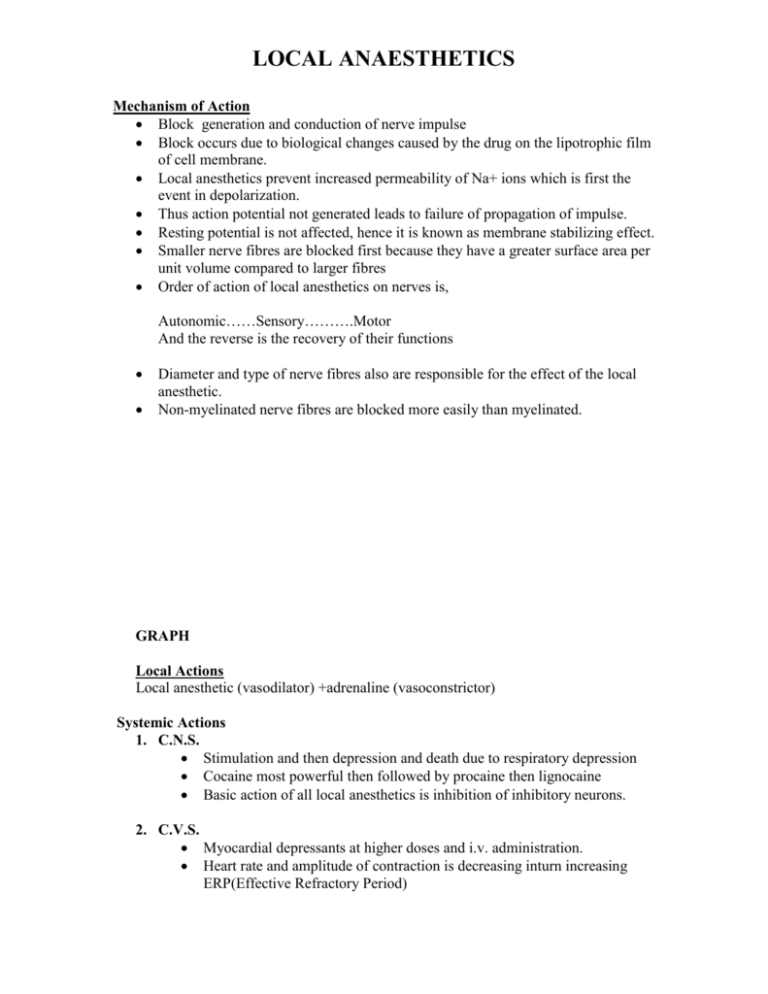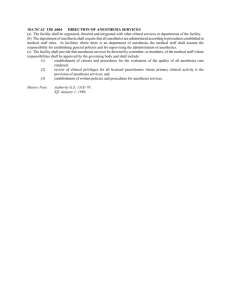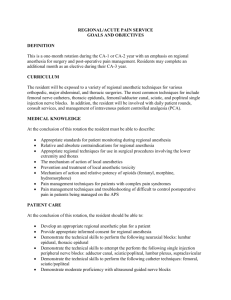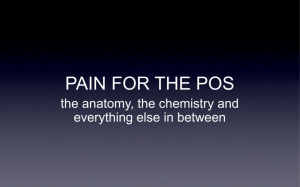MOA of LA - PharmaXChange.info
advertisement

LOCAL ANAESTHETICS Mechanism of Action Block generation and conduction of nerve impulse Block occurs due to biological changes caused by the drug on the lipotrophic film of cell membrane. Local anesthetics prevent increased permeability of Na+ ions which is first the event in depolarization. Thus action potential not generated leads to failure of propagation of impulse. Resting potential is not affected, hence it is known as membrane stabilizing effect. Smaller nerve fibres are blocked first because they have a greater surface area per unit volume compared to larger fibres Order of action of local anesthetics on nerves is, Autonomic……Sensory……….Motor And the reverse is the recovery of their functions Diameter and type of nerve fibres also are responsible for the effect of the local anesthetic. Non-myelinated nerve fibres are blocked more easily than myelinated. GRAPH Local Actions Local anesthetic (vasodilator) +adrenaline (vasoconstrictor) Systemic Actions 1. C.N.S. Stimulation and then depression and death due to respiratory depression Cocaine most powerful then followed by procaine then lignocaine Basic action of all local anesthetics is inhibition of inhibitory neurons. 2. C.V.S. Myocardial depressants at higher doses and i.v. administration. Heart rate and amplitude of contraction is decreasing inturn increasing ERP(Effective Refractory Period) LOCAL ANAESTHETICS Procainamide is a classical anti-arrhythmic drug. Bupivacaine is cardio toxic and causes fibrillation. Hypotension caused due to fall in the blood pressure is because local anesthetics have vasodilator action on blood vessels. Exception: Cocaine has vasodilator effect. 3. Other actions Spasmolytic action on the smooth muscles and produces neuromuscular blockage at higher doses. Adverse Effects 1. Intolerance Mild allergic dermatitis Asthmatics attack Usually side-effects seen with ester linked local anesthetics and show cross sensitivity with chemically related compounds. 2. C.N.S. Pre-anesthetic dose of diazepam prevents situations like light headedness, dizziness, twitching, etc. Preventive measures that are taken are: Oxygen to prevent hypoxia. Short acting barbiturates ma also be given but it has an additive action with local anesthetics and can cause adverse side effects. 3. C.V.S. Fall in blood pressure occurs; hence vasoconstrictors like noradrenalin and ephedrine are used. Therapeutic Uses 1. Surface Anesthesia Application on skin, mucous membranes and abraded skin. Only superficial layer is anesthetized. Onset and duration of action depends upon: a. Site b. Drug c. Concentration d. Formulation Lignocaine spray is used for throat anesthetizing properties Except for the eutectic mixture of lignocaine and prilocaine no other local anesthetic has the ability to anesthetize intact skin. I.V. administrations are avoided as they cause systemic toxicity. LOCAL ANAESTHETICS 2. Infiltration anesthesia Dilute solutions of local anesthetics are infiltrated under the skin to block sensory nerve endings by subcutaneous infiltration. Short onset of action. Used for minor operations like incisions and herniorrhaphy. Adrenaline is avoided when local anesthetics are used for blocks to anesthetize digits or penis in order to avoid local ischemia and in patients with myocardial disease. 3. Conduction block Local anesthetics infected around nerve trunk so the area distal to it is anesthetized or paralyzed. There are two types of conduction block anesthesia: a. Field Block: Subcutaneous infection so that all nerve coming to a particular field are blocked. E.g. scalp stitching, operations on forearms or legs. b. Nerve Block: Injection of local anesthetic around autonomic nerve trunk or plexuses. Area of anesthesia is larger compared to amount of drug used. Latency of anesthesia depends upon drug and area to be covered under diffusion. For plexus block flooding technique is used. Nerve block has longer duration of action than field block. E.g. tooth extraction, fracture setting 4. Spinal Anesthesia Tetracaine is used for this type of anesthesia. Injected in sub-arachnoid’s space between L2-3 or L3-4 i.e. below lower end of spinal cord. Solutions used are hypobaric or hyperbaric than CSF. They are made ‘heavy’ by adding dextrose and ‘light’ (approx. isotonic) using saline. The duration of spinal anesthesia used depends upon drug and its concentration. Adrenaline is added to increase the duration of action of local anesthetic. Spinal anesthesia is used for lower limbs, pelvis and obstetric procedures. It is better than general anesthesia as it is safer and good muscle relaxation without loss of consciousness. Complication of spinal anesthesia is as follows: a) Sympathetic nerve blockade produces arteriolar dilation. b) Decreased venous tone and post arteriolar pooling of blood and decreased venous return to the heart. LOCAL ANAESTHETICS c) d) e) f) Cardiac out put is reduced and blood pressure decreases. It also leads to bradycardia. Headache due to seepage of CSF. Cauda equine syndrome: Prolonged loss of control over bladder and bowel sphincters. g) Septic meningitis due to infection during puncture. It rarely occurs. h) Nausea and vomiting occurs after abdominal operation. 5. Epidural anesthesia E.g. Lignocaine and Bupivacaine Spinal dural space is filled with semiliquid fat through which nerve roots travel. There are three categories of epidural anesthesia. a. Thoracic anesthesia Injection in mid-thoracic region. Small volume of drug. b. Lumbar anesthesia Large volume of drug. Uses similar to spinal anesthesia. c. Caudal anesthesia Given in sacral canal through sacral hiatus. Vaginal delivery and genitor-urinary operations. 6. Intravenous regional anesthesia Consist of injection of local anesthetic in a vein of a tourniquet occluded limb such that the drug diffuses retrograde from peripheral vascular bed to non-vascular tissues including nerve ending. Used for upper limb and orthopedic procedures.









